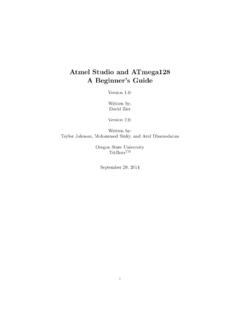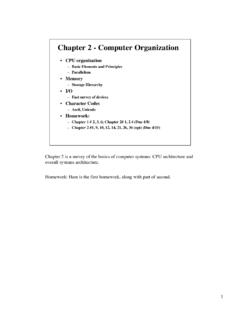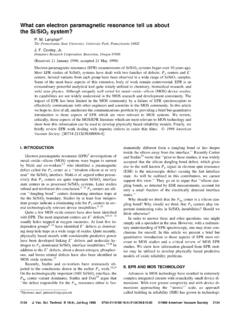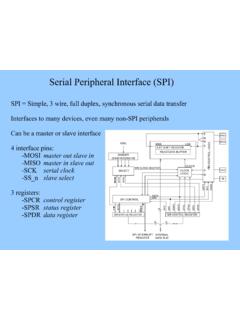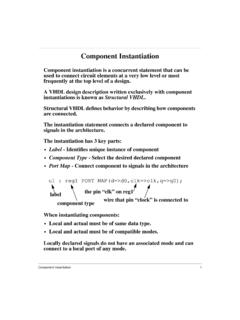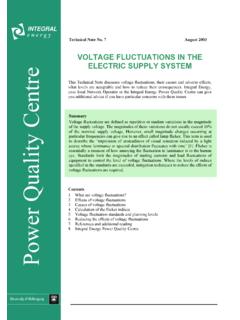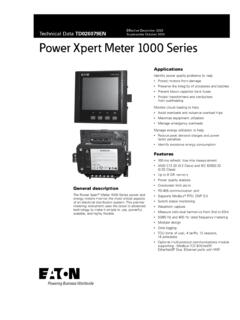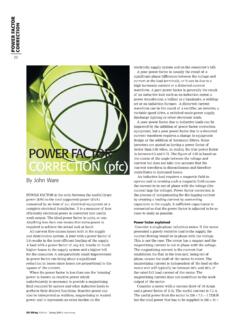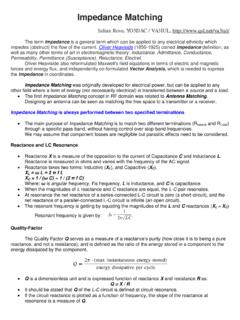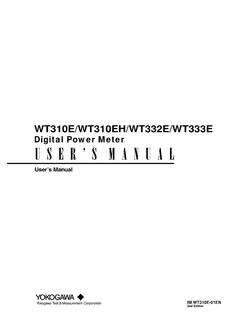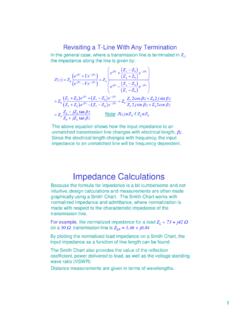Transcription of SECTION 9: ELECTRICAL POWER DISTRIBUTION
1 ESE 470 Energy DISTRIBUTION SystemsSECTION 9: ELECTRICAL POWER DISTRIBUTIONK. WebbESE 470 Introduction2K. WebbESE 4703 The ELECTRICAL Grid Three main components to the ELECTRICAL grid Generation ESE 450 Transmission Transmission Subtransmission DISTRIBUTION Primary DISTRIBUTION Secondary DISTRIBUTION Different voltage levels at each Connected by transformersK. WebbESE 4704 Transmission Network Provides bulk powerfrom generators to the grid Interconnection point between separate utilities or separate generators POWER bought and sold at this level High voltage for low loss, long-distance transmission kV Generator step up transformers at POWER plant High POWER MVAper three-phase circuit Transmission network terminates at bulk-poweror transmission substationsK.
2 WebbESE 4705 Subtransmission Network Voltage stepped down at bulk- POWER substations Typically 69 kV, but also 115 kVand 138 kV Large industrial customers may connect directly to the subtransmission network Voltage stepped down at customer s substation Subtransmission network terminates at DISTRIBUTION substationsK. WebbESE 4706 Primary DISTRIBUTION Voltage stepped down at DISTRIBUTION substations kV .. 46 kV 4 MVA .. 30 MVA Feedersleave substations and run along streets Lateralstap off of feeders and run along streets Primary DISTRIBUTION network terminates at DISTRIBUTION transformersK. WebbESE 4707 Secondary DISTRIBUTION DISTRIBUTION transformers step voltage down to customer utilization level Single-phase 120 V .. three-phase 480 V Secondary DISTRIBUTION is the connection to the customer May connect to a secondary main Serves several customers Or, one DISTRIBUTION transformer may serve a single customerK.
3 WebbESE 470 Primary Distribution8K. WebbESE 4709 DISTRIBUTION Substations Primary DISTRIBUTION network is fed from distributionsubstations: Step-down transformer kV .. 46 kV Typically 15 kV class: kV, kV, or kV Circuit protection Surge arresters Circuit breakers Substation bus feeds the primary DISTRIBUTION network Feedersleave the substation to distribute POWER into the service area in one of three topologies Primary radialsystem Primary loopsystem Primary networksystemK. WebbESE 47010 Primary Radial System Multiple radial feeders may leave a single substation Each load in the service area served by a single feeder Feeders run along streets Overhead or underground Laterals tap off of feeders Overhead or undergroundsource: Glover, Sarma, OverbyeK.
4 WebbESE 47011 Primary Loop System Primary loop systemsprovide a reliability improvement over radial systems Two feeders loop from the DISTRIBUTION substation through service area Normally-open tie switch completes the loop Reclosers around the loop isolate faults Tie switch closes to provide service downstream of isolated sectionsource: Glover, Sarma, OverbyeK. WebbESE 47012 Primary Network System Primary network systemprovides further reliability improvement Service area supplied by a grid of interconnected feeders Feeders originate from multiple substations Used in densely-populated urban centerssource: Glover, Sarma, OverbyeK. WebbESE 470 Secondary Distribution13K. WebbESE 47014 Secondary DISTRIBUTION The secondary DISTRIBUTION networkconnects customers to the primary DISTRIBUTION network DISTRIBUTION transformers step voltages down to customer utilization levels Common secondary DISTRIBUTION voltages: Single-phase 120/240 V Three wire ResidentialK.
5 WebbESE 47015 Secondary DISTRIBUTION Common secondary DISTRIBUTION voltages (cont d): Three-phase/single-phase 208Y/120 V Four wire Dense residential/commercial Three-phase/single-phase 480Y/277 V Four wire Commercial/industrial/high rise Single-phase 277 V for fluorescent lighting Three-phase 480 V for motors Transformers provide single-phase 120 V for outletsK. WebbESE 47016 DISTRIBUTION Transformers DISTRIBUTION transformersstep voltages down to customer levels Pole-mount Pad-mount Vault Two possible configurations: One transformer per customer Common secondary mainK. WebbESE 47017 DISTRIBUTION Transformers One DISTRIBUTION transformer per customer Rural areas Large loads Common secondary main One transformer serves several customers Densely-populated areas Multiple transformers may connect in parallel to the secondary main banked secondary K.
6 WebbESE 470 Ancillary Services18K. WebbESE 47019 Ancillary Services Primary function of the ELECTRICAL POWER system is to supply the exact amount of POWER required to satisfy demand Constantly fluctuating load Adequate POWER quality and reliability must be maintained Ancillary services:all of the secondary functions of the electric utilities necessary to ensure POWER quality and reliability Some provided at the generation level Some at the transmission and DISTRIBUTION networksK. WebbESE 47020 Ancillary Services FERC regulations specify ancillary service requirements for utilities Capability to inject POWER real and reactive onto the grid as needed Services differ in the time frame corresponding to the required POWER Ancillary Services: Load following Frequency regulation Voltage regulation Spinning reserve Supplemental reserve Replacement reserveK.
7 WebbESE 47021 Ancillary Services Load following Variation of generated POWER to track the daily load profile Response time: minutes to hours Location: generation Frequency regulation Tracking of short-term load variations to ensure that grid frequency remains at 60 Hz Response time: seconds to minutes Location: typically at the generatorK. WebbESE 47022 Ancillary Services Voltage regulation Maintaining line voltage levels near nominal values Injection or absorption of reactive POWER Adjusting transformer tap settings Response time: seconds Location: generation, transmission, DISTRIBUTION Spinning reserve Online generation with spare capacity Able to respond quickly to compensate for generation outages Response time: seconds to minutes Location: generationK.
8 WebbESE 47023 Ancillary Services Supplemental reserve Online or offline spare generation capacity Response time: minutes Location: generation Replacement reserve Typically offline generation capacity Takes over for spinning and supplemental reserves Response time: tens of minutes Location: generationK. WebbESE 47024 Ancillary Services Response Timesource: Frequency Regulation Basics and Trends, Brendan J. Kirby, 2004K. WebbESE 47025 Regulation and Load Followingsource: Frequency Regulation Basics and Trends, Brendan J. Kirby, 2004K. WebbESE 47026 Voltage Regulation Many of the required ancillary services are provided at the generation level As storage technologies advance, some will be moved to the DISTRIBUTION network Voltage regulation occurs, in large part, in the transmission and DISTRIBUTION networks Two primary means of voltage regulation in the transmission/ DISTRIBUTION networks: Reactive POWER control Varying transformer tap settingsK.
9 WebbESE 47027 Voltage Regulation Reactive POWER Control As reactive POWER at the load varies, line voltage varies Shunt compensation elements switched in and out with varying load Static varcompensators (SVCs) at transmission substations Shunt capacitors located along primary feeders Switched based on local measurements Switched remotely from a control centersource: WebbESE 47028 Voltage Regulation Load Tap Changers Transformers with adjustable turns ratios Located at DISTRIBUTION substations Internal motors automatically adjust secondary-side tap settings Load Tap Changers (LTCs)source: Glover, Sarma, OverbyeK. WebbESE 47029 Voltage Regulation Voltage Regulators Autotransformers with automatically-variable tap settings At DISTRIBUTION substations or along primary feeders Internal motors automatically adjust secondary-side tap settings Voltage Regulatorssource: WtshymanksiK.
10 WebbESE 470 DISTRIBUTION Reliability30K. WebbESE 47031 DISTRIBUTION Reliability Primary function of the ELECTRICAL POWER system is to supply the required load andto do so reliably Several commonly-used DISTRIBUTION reliability metrics Measures of the amount of service interruption over a period of time System Average Interruption Frequency Index (SAIFI) Average number of interruptions per customer per year =# # N. American median interruptionsK. WebbESE 47032 DISTRIBUTION Reliability System Average Interruption Duration Index (SAIDI) Average outage time per customer per year = # N.
